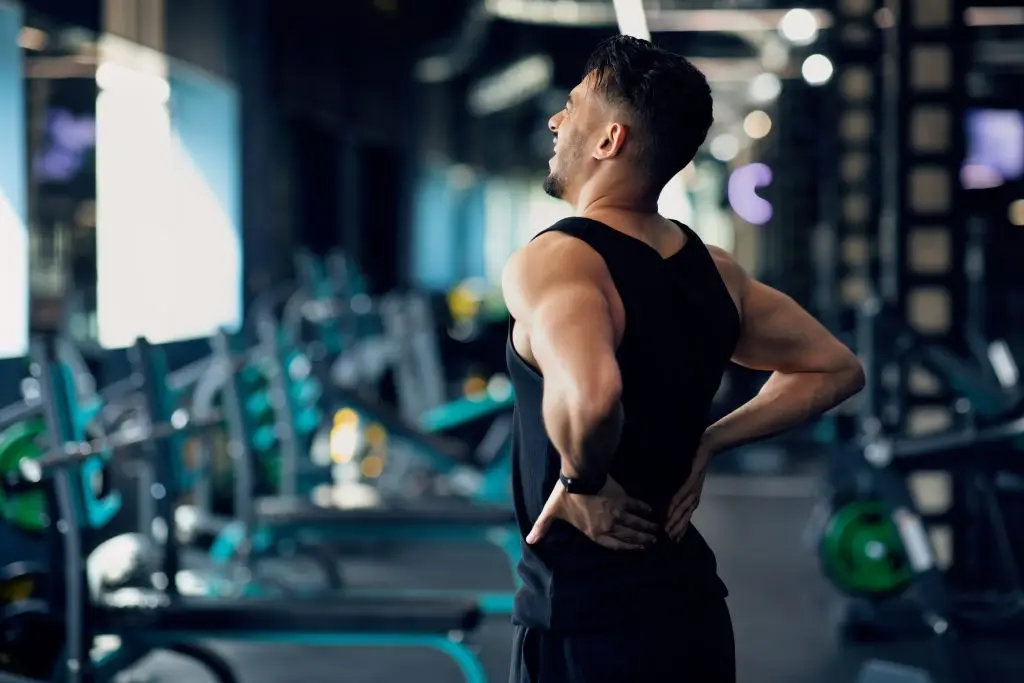Lower back pain after a workout can be frustrating, whether you’re a fitness beginner just starting your gym routine or a seasoned athlete pushing your limits. It’s even more concerning when you’re unsure whether the discomfort you’re feeling is simply post-workout soreness or something more serious.
The good news is that most cases of back discomfort can be managed effectively, and the likelihood of long-term damage is low, especially if you address the issue early. If you’re really worried or the pain doesn’t go away on its own, remember that you can always visit a physical therapist at SOL without needing a referral.
Common causes of back pain for active individuals
Figuring out the root cause of your lower back pain can make all the difference in addressing it effectively. Here are the most common culprits and their associated symptoms.
Muscle strain
A muscle strain occurs when the fibers in your muscles or tendons are overstretched or torn, often due to overuse or improper form.
Symptoms of low back muscle strains include:
- Sudden sharp pain during or immediately after movement
- Swelling or tenderness in the lower back
- Stiffness, particularly after resting
Muscle strain is often linked to exercises that require heavy lifting, twisting, or sudden, explosive movements. Beginners are particularly susceptible if they haven’t yet built up adequate strength for their workout routine.
Herniated disc
A herniated disc happens when the soft material inside a spinal disc pushes through a gap in the outer layer, often compressing nearby nerves.
Symptoms of herniated discs include:
- Sharp, shooting pain in the lower back that may radiate down the leg
- Numbness or tingling in one or both legs
- Weakness in a leg or foot
This issue can arise from performing exercises with improper spinal alignment, such as deadlifts or squats, that place excessive pressure on the discs.
SI joint pain
The sacroiliac (SI) joint connects the base of your spine to your pelvis, and excessive stress on it can result in inflammation and discomfort.
Symptoms of SI joint injury include:
- Pain localized to one side of the lower back or buttocks
- Pain that worsens with prolonged standing or climbing stairs
SI joint pain often stems from repetitive heavy lifting or activities that place uneven stress on the pelvis, like lunges or single-leg exercises.
Chronic condition
Existing conditions such as arthritis, scoliosis, or degenerative disc disease can contribute to lower back pain after workouts. These conditions are often exacerbated by high-impact or high-intensity activities.
Each condition that might be affecting you will have different symptoms, which may include:
- Persistent, dull aching that doesn’t improve with rest
- Limited range of motion in the back
- Discomfort that flares up after specific types of exercise
Beyond specific underlying conditions, a lack of strength, stability, or flexibility might put strain on your back, increasing the risk of pain. This is why it’s important to start slowly if you’re new to a certain type of workout, getting advice from a licensed athletic trainer or physical therapist if possible.
Sustainable habits for pain-free exercise
Despite the numerous benefits of strength training and exercise in general, working out requires a proactive approach to avoid injuries like low back pain, with sustainable habits that protect your back and support your overall fitness goals. Here are several ideas to help you stay active without injuries:
1. Prioritize proper form
One of the most effective ways to prevent lower back pain is ensuring correct technique during exercises, especially movements like squats, deadlifts, and climbing. Improper form is a leading cause of muscle strain and injury, especially during strength training.
- Keep your spine neutral during movements
- Engage your core to provide stability to your lower back
- Don’t rush your lifts—control your movements
2. Warm up and cool down
“Cold” muscles are more prone to injury, so always warm up before exercising. Dynamic stretches and light versions of the workout you’re about to do can help prepare your muscles and joints for the full activity. After your workout, focus on mobility exercises to cool down and reduce stiffness.
Warm-up example:
- 5–10 minutes of light jogging or cycling
- Dynamic stretches, like leg swings or torso twists
Cool-down examples:
- Gentle yoga poses like cat-cow
- Foam rolling to relieve tightness
3. Build core strength
The core is your body’s foundation, supporting your spine and preventing excess stress on your back. Weak core muscles can make you more susceptible to lower back injuries. That’s why, no matter what your goals from exercise or strength training, focusing on your core is key to staying healthy overall.
Examples of core-strengthening exercises include planks and bird dogs. Keep in mind that core exercises should focus on stability rather than crunching or twisting motions, which can strain the lower back further.
4. Gradually increase intensity
Sudden changes to your routine—such as heavier weights or longer workouts—can overwhelm your muscles and joints if they’re not used to it. Adopt a progressive approach by increasing intensity, load, or duration by no more than 10% per week to give your body time to adapt.
5. Consult a PT for injury prevention
Working with a physical therapist is an invaluable step in preventing injuries, especially if you’re changing your routine or training for a specific sport. PTs can help you:
- Identify and correct muscular imbalances
- Develop a personalized exercise plan tailored to your goals
- Learn recovery techniques to stay pain-free
6. Rest and recover
Your muscles need time to repair and grow stronger between workouts, so don’t skip rest days. Use this time for gentle, restorative activities like walking or yoga to keep your body moving without overdoing it.
SOL Performance training with physical therapy specialists
Lower back pain after a workout shouldn’t be a regular experience. By understanding the causes of discomfort, adopting sustainable exercise habits, and prioritizing expert guidance when needed, you can take control of your fitness and stay injury-free.
At SOL, we do more than just help folks heal after surgery or injury; we’re here to help you reach your peak fitness level and athletic goals with evidence-backed personal training techniques based in physical therapy principles. Discover what sets our team apart from the average trainer by giving our team a call or requesting a performance appointment online today.

